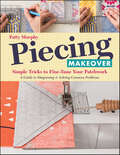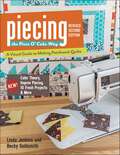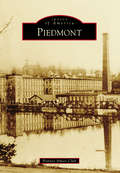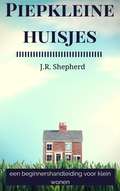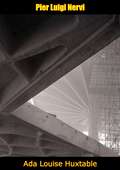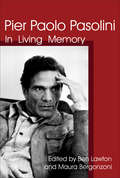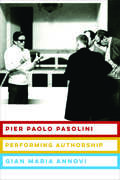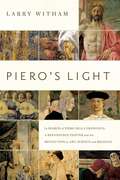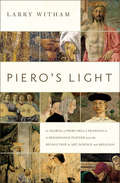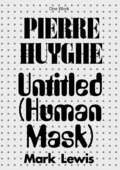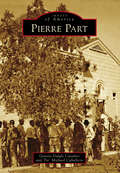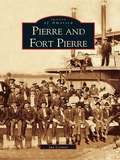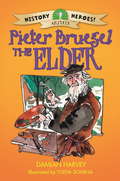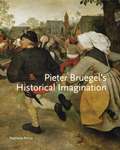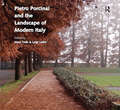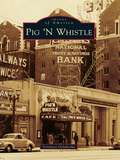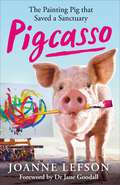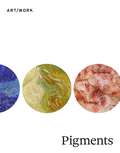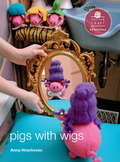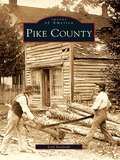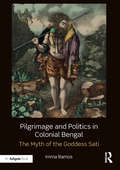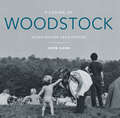- Table View
- List View
Piecing Makeover: Simple Tricks to Fine-Tune Your Patchwork
by Patty MurphyDo your quilt blocks tend to misbehave? Perfect your patchwork with a visual, step-by-step guide to 21 popular quilt blocks. Piecing expert Patty Murphy shows you how with fail-proof techniques that can be used in all types of quilt designs, from traditional to modern. Say goodbye to patchwork problems like mismatched seams, blunt points, and too-small blocks, and learn to avoid common mistakes in sashings, borders, and bindings. Though mistakes happen to all of us, these easy techniques will help beginning and intermediate quilters achieve quiltmaking success every time. • Learn to flawlessly construct 21 popular blocks in both traditional and modern designs • Step-by-step photos guide new and intermediate quilters • Avoid common patchwork problems like mismatched seams with expert tips from a lifelong quilter
Piecing the Piece O' Cake Way: A Visual Guide to Making Patchwork Quilts
by Becky Goldsmith Linda JenkinsThe Only Patchwork Basics Book You’ll Need From planning to binding, learn the right way to do patchwork with best-selling authors from Piece O’ Cake Designs. Before they taught appliqué, Linda Jenkins and Becky Goldsmith shared a love of—piecing and they’re still avid patch workers today! Start with simple strips, squares, and half-square triangles. Then stretch your skills with diamonds, curves, and improv piecing. This visual guide to quiltmaking basics includes 10 colorful projects, skill-building techniques, and tips for fabulous fabric selection. • Everything you need to know about quiltmaking from patchwork experts from Piece O’ Cake Designs • Expanded second edition! New quilts, improved techniques, and color choices made easy • Handy, visual guide lies flat for easy reference • Complete guide to quilting basics including sewing scant quarter-inch seams, cutting fabric that’s larger than your cutting mat, sewing perfectly placed points, and more
Piecing: Expanding The Basics
by Ruth B. McDowellThe renowned quilt artist and author of Ruth McDowell’s Piecing Workshop offers an advanced class in piecing for quilters who have mastered the basics.Almost everyone who views a Ruth McDowell quilt wants to know, “How did she piece that?” Now Ruth shares her sought-after techniques for piecing curved seams, insets, multiple angles, Z seams, Y seams, puzzle seams, diagonals, intersecting seams, slipped seams, and much more. Beginning with a photo or sketch, Ruth walks you through the individual steps of piecing and offers problem-solving suggestions along the way. You’ll learn her methods for original piecing design, as well as how to select fabrics and find your own working style. This book will appeal to traditional and contemporary quiltmakers alike.
Piedmont (Images of America)
by Bonnes Amies ClubAstride a mighty river separating Greenville and Anderson Counties in the foothills of the Blue Ridge Mountains, Piedmont is a place divided--divided by a river, a county line, and school district lines. But, more importantly, it is tied, connected, and bridged together by its enduring story. Swift and deep, the Saluda River attracted Native Americans, Revolutionary War soldiers, and early settlers to the ford at the shoals. Called Big Shoals of the Saluda by the Cherokee and Garrison Shoals by the settlers, the ford supported a British garrison, an early gristmill, and a venture into textile manufacturing. In fact, Piedmont Manufacturing Company was one of the earliest and largest mills in the South. Today, still spanning the Saluda and linking the mill sites to allow swift crossing, the footbridge connects today's residents to the souls these waters have affected for hundreds of years.
Piepkleine huisjes: een beginnershandleiding voor klein wonen
by Ynze Bakker J. R. ShepherdLeef gelukkig door klein te wonen! Heb jij je ooit afgevraagd hoe het zou zijn om in een piepklein huisje te wonen? Droom je van een lagere hypotheek? Of helemaal geen hypotheek? Vind je "groen" leven belangrijk? Wil je wat eenvoudiger wonen en je concentreren op de dingen in het leven die echt belangrijk zijn? Dan zou een piepklein huisje voor jou de perfecte oplossing kunnen zijn! Dit boek verkent piepkleine huisjes en de levensstijl die ermee gepaard gaat. Het geeft jou een idee of een piepklein huisje nuttig is voor jou en helpt je bij de overgang naar het idee van groot wonen in een kleine ruimte. In piepkleine huisjes: een beginnershandleiding voor klein wonen leer je: - Voor wie piepkleine huisjes het meest geschikt zijn; - Hoe piepkleine huisjes jou helpen om jouw onnodige bezittingen te verminderen en je te concentreren op de dingen in het leven die echt belangrijk voor jou zijn; - Tips voor het ontwerpen en inrichten om je te helpen het meeste te halen uit de ruimte in jouw piepkleine huisje; - De fysieke en emotionele voordelen van het adopteren van de piepkleine huisjes levensstijl; - En nog veel meer! Piepkleine huisjes gaan over het je concentreren op wat het belangrijkst is voor jou - relaties, hobby's, werk, natuur of gemeenschap. Het is nooit te laat om je op iets anders te concentreren, en piepkleine huisjes: een beginnershandleiding voor klein wonen, helpt je om dat te bereiken! Leef gelukkig door klein te wonen!
Pier Luigi Nervi: Masters Of World Architecture
by Ada Louise HuxtableThis book by Pulitzer-Prize-winning critic Ada Louise Huxtable is a monograph on the great Italian architect and structural engineer Pier Luigi Nervi (1891-1979), which was first published in 1960.PIER LUIGI NERVI was born in Sandrio, Italy, on June 21, 1891. He completed his formal studies at the civil engineering school of the University of Bologna in 1913. After graduating, he worked for the Società per Costruzioni Cementizie until 1920, receiving thorough experience in the design of reinforced concrete. In 1920 he formed the partnership of Soc. Ing. Nervi e Nebbiosi. During this association, which lasted until 1932, several noteworthy structures were built, especially the Florence Municipal Stadium. In 1932 he joined with a cousin to form Ingg. Nervi e Bartoli, the design and construction firm which he headed; the famous airplane hangars of 1938-1943, won by the firm in competition, brought Nervi international attention.In the mid-1940s he developed the versatile material “Ferro-cementa,” a system of layers of fine steel mesh sprayed with cement mortar, which he used in the extraordinary Grand Salon of the Turin Exhibition Hall (1949). With this, building, Nervi became firmly established as one of the world’s foremost engineers, a reputation reinforced again and again by subsequent works, including the completion of three stadia for the 1960 Olympics in Rome.A member of the International Congresses of Modern Architecture (CIAM), he was also Professor of Technology and Construction Techniques at the University of Rome. He was awarded Gold Medals by the Institution of Structural Engineers in the UK, the American Institute of Architects (AIA Gold Medal 1964) and the RIBA. In 1957, he received the Frank P. Brown Medal of The Franklin Institute and the Wilhelm Exner Medal.Pier Luigi Nervi died on January 9, 1979 at the age of 87.
Pier Paolo Pasolini: In Living Memory
by Ben Lawton and Maura BergonzoniA collection of essays discussing the famed Italian film director, writer, and intellectual.More than thirty years after the tragic death of Pier Paolo Pasolini, this volume is intended to acknowledge the significance of his living memory. His artistic and cultural production continues to be a fundamental reference point in any discourse on the state of the arts, and on contemporary political events, in Italy and abroad. This collection of essays intends to continue the recognition of Pasolini’s teachings and of his role as engaged intellectual, not only as acute observer of the society in which he lived, but also as semiologist, writer, and filmmaker, always heretical in all his endeavors. Many directors, reporters, and contemporary writers see in the “inconvenient intellectual” personified by Pasolini in his writings, in his films, and in his interviews, an emblematic figure with whom to institute and maintain a constant dialog, both because of the controversial topics he addressed, which are still relevant today, and because of the ways in which he confronted the power structures. His analytical ability made it impossible for him to believe in the myth of progress; instead, he embraced an ideal that pushed him always to struggle on the firing line of controversy.
Pier Paolo Pasolini: Performing Authorship
by Gian Maria AnnoviBefore his mysterious murder in 1975, Pier Paolo Pasolini had become famous—and infamous—not only for his groundbreaking films and literary works but also for his homosexuality and criticism of capitalism, colonialism, and Western materialism. In Pier Paolo Pasolini: Performing Authorship, Gian Maria Annovi revisits Pasolini's oeuvre to examine the author's performance as a way of assuming an antagonistic stance toward forms of artistic, social, and cultural oppression. Annovi connects Pasolini's notion of authorship to contemporary radical artistic practices and today's multimedia authorship.Annovi considers the entire range of Pasolini's work, including his poetry, narrative and documentary film, dramatic writings, and painting, as well as his often scandalous essays on politics, art, literature, and theory. He interprets Pasolini's multimedia authorial performance as a masochistic act to elicit rejection, generate hostility, and highlight the contradictions that structure a repressive society. Annovi shows how questions of authorial self-representation and self-projection relate to the artist's effort to undermine the assumptions of his audience and criticize the conformist practices that the culture industry and mass society impose on the author. Pasolini reveals the critical potential of his spectacular celebrity by using the author's corporeal or vocal presence to address issues of sexuality and identity, and through his strategic self-fashioning in films, paintings, and photographic portraits he destabilizes the audience's assumptions about the author.
Piero's Light
by Larry WithamIn the tradition of The Swerve and Galileo's Daughter, Piero's Light reveals how art, religion and science came together at the dawn of the modern world in the paintings of one remarkable artist.An innovative painter in the early generation of Renaissance artists, Piero dell Francesca was also an expert on religious topics and a mathematician who wanted to use perspective and geometry to make painting a &“true science.&” Although only sixteen of Piero&’s works survive, few art historians doubt his importance in the Renaissance. A 1992 conference of international experts meeting at the National Gallery of Art deemed Piero, &“One of the most highly regarded painters of the early Renaissance, and one of the most respected artists of all time.&” In recent years, the quest for Piero has continued among intrepid scholars, and Piero's Light uncovers the life of this remarkable artistic revolutionary and enduring legacy of the Italian Renaissance.
Piero's Light: In Search of Piero della Francesca: A Renaissance Painter and the Revolution in Art, Science and Religion
by Larry WithamAn innovative painter in the early generation of Renaissance artists, Piero dell Francesca was also an expert on religious topics and a mathematician who wanted to use perspective and geometry to make painting a "true science."Although only sixteen of Piero's works survive, few art historians doubt his importance in the Renaissance. A 1992 conference of international experts meeting at the National Gallery of Art deemed Piero "one of the most highly regarded painters of the early Renaissance, and one of the most respected artists of all time." In recent years, the quest for Piero has continued among intrepid scholars, and Piero's Light uncovers the life of this remarkable artistic revolutionary and enduring legacy of the Italian Renaissance.
Pierre Huyghe: Untitled (Human Mask) (Afterall Books / One Work)
by Mark LewisAn examination of Pierre Huyghe's post-apocalyptic Untitled (Human Mask), which asks whether our human future may be one of remnants and mimicry.Pierre Huyghe's 2014 film Untitled (Human Mask) combines images of a post-apocalyptic world (actual footage of deserted streets close to the Fukushima Daiichi nuclear disaster of March 2011) with a haunting scene of a monkey working in an empty restaurant wearing a human mask and a wig. She's a girl! The flat, emotionless almost automaton state of the mask and the artificial glossy hair topped even with a child's bow, suggests that she, the monkey, might be a character from Japanese Noh theatre. But there's no music. Instead Huyghe's film evinces the terrifying possibility that our own, human, future might just be one of remnants and mimicry; that the deserted streets of Fukushima and the monkey's recognizable, alienating chimeric performance is all that might survive us. Untitled (Human Mask) presents a pluperfect world with extinction the endgame for a civilization that cared little for the present, dreaming only of a future that inevitably and necessarily could not include it.
Pierre Part
by Tre' Michael Caballero Geneve Daigle CavalierPierre Part and Belle River rest in an area once known as the Atchafalaya Basin. Between 1770 and 1773, a young Canadian named Pierre Part set foot on the banks of what he called La Bay de Lac Verret. He was with the Spanish colonial militia under the command of Commandant Nicholas Verret Sr., a French Canadian. Part considered this place a beautiful wilderness and asked his superior for permission to establish a settlement--his request was not granted. The military returned Part to the Spanish military post at Valenzuela, and although he never made this area his home, his name remains. Other French explorers came much earlier than Part, and some of the area's waterways bear French names: Le Belle Rivere, Le Lac de Natchez, Bayou de Magazille, Bayou de Lantania (Palmetto), Bayou de Postillion, Le Lac de Palourde, and Le Bayou Milhomme. In 1780, Acadian French-speaking people moved to Pierre Part from Burlie des Olivers and Burlie Saint Vincent. Small groups came and settled together at various places within sight of each other. In 1803, a small settlement of families, which is believed to have included the Solors and Berthelots and later the Heberts and the Pipsairs, settled on the banks of Lake Verret, where Bayou Pierre Part flows into the lake.
Pierre and Fort Pierre (Images of America)
by Jan CerneyFrom prairie to river's edge, the Pierre and Fort Pierre area resounds with historical adventure. Visited in 1743 by French explorers-the Verendrye brothers-and by Lewis and Clark in 1804, Fort Pierre was established as a significant fur trading post in 1817 and served briefly as a military fort in 1855. The decaying port settlement was revived during the Black Hills gold rush of 1875, outfitting bull trains. For over a decade, it bustled with freighting activity and stagecoach travel on the Fort Pierre-Deadwood gold trail. When the Chicago, Northwestern Railroad reached the Missouri River in 1880, Fort Pierre's sister city, Pierre, emerged as an important river town. During the days of the open range, Fort Pierre served as a holding place for the millions of cattle to be ferried across the Missouri to the trains at Pierre. In 1889, Pierre was named capital of the state and became the political heart of South Dakota. When nearby reservations opened for settlement, the cattle range began to fill with settlers, changing the scene once again. In these pages, a pictorial history unfolds, the drama of men and women who lived out their dreams near the Missouri.
Pieter Bruegel the Elder (History Heroes #7)
by Damian HarveyPieter Bruegel, the greatest Flemmish painter of the 16th Century, developed a unique style of painting and created many masterpieces, often painting scenes of daily life.Discover the stories of people who have helped to shape history, ranging from early explorers such as Christopher Columbus to more modern figures like Tim Berners-Lee, inventor of the World Wide Web.These chapter books combine historical fact with engaging narrative and humourous illustration, perfect for the newly independent reader.
Pieter Bruegel’s Historical Imagination
by Stephanie PorrasThe question of how to understand Bruegel’s art has cast the artist in various guises: as a moralizing satirist, comedic humanist, celebrator of vernacular traditions, and proto-ethnographer. Stephanie Porras reorients these apparently contradictory accounts, arguing that the debate about how to read Bruegel has obscured his pictures’ complex relation to time and history. Rather than viewing Bruegel’s art as simply illustrating the social realities of his day, Porras asserts that Bruegel was an artist deeply concerned with the past. In playing with the boundaries of the familiar and the foreign, history and the present, Bruegel’s images engaged with the fraught question of Netherlandish history in the years just prior to the Dutch Revolt, when imperial, religious, and national identities were increasingly drawn into tension. His pictorial style and his manipulation of traditional iconographies reveal the complex relations, unique to this moment, among classical antiquity, local history, and art history. An important reassessment of Renaissance attitudes toward history and of Renaissance humanism in the Low Countries, this volume traces the emergence of archaeological and anthropological practices in historical thinking, their intersections with artistic production, and the developing concept of local art history.
Pietro Porcinai and the Landscape of Modern Italy
by Marc Treib Luigi LatiniBorn in Florence in 1910, Pietro Porcinai grew up on the classic grounds of the Villa Gamberaia in Settignano where his father served as head gardener. Although he studied agriculture in college, Porcinai’s true interest lay in the landscape architecture practice he founded in 1938. Early projects centered in the area of Arezzo, whose style reflected modernÂized traditional models. In the postwar era the office flourished, producing modern gardens of remarkable design and use of plants. In these works, Porcinai convincingly demonstrated the affinity between historical architecture and landscapes unÂcompromisingly modern. During his long and productive career he also consulted on autostrada planning, and designed public parks, memorials, and even a Pinocchio theme park-at times collaborating with noted architects such as Renzo Piano, Carlo Scarpa and Oscar Niemeyer. This book, the first English-language study on Pietro Porcinai provides a comprehensive and richly illustrated overview of his life and remarkable achievements.
Pig 'N Whistle
by Veronica GelakoskaThe Pig 'N Whistle restaurants operated from 1908 to 1968 at more than 40 locations on the West Coast, from Los Angeles to Seattle. These elegant lunch rooms in San Francisco, Oakland, Beverly Hills, Pasadena, and elsewhere were born out of the great 1906 San Francisco Earthquake when hotelier John H. Gage left Hotel America and the rubble on Market Street to make a fresh start. He opened a soda fountain next door to Los Angeles City Hall in 1908 and soon returned to San Francisco to open a second in the newly rebuilt White House Department Store. Dutch immigrant Sidney Hoedemaker became the chain's president, and under his direction, Pig 'N Whistle added Melody Lane, one of the first L.A. restaurants to open a cocktail bar, a development mirrored in the Hollywood film noir classic, Mildred Pierce.Restaurateur Chris Breed and partner Alain Hajjar reinvigorated the memory of the Egyptian Theatre Pig 'N Whistle by reestablishing the classic franchise in 2001 on Hollywood Boulevard.
Pigcasso: The painting pig that saved a sanctuary
by Joanne LefsonWhen Joanne Lefson took on a piglet at her animal shelter, the young sow proceeded to eat everything in her stable but a paint brush. In a flash of inspiration, Joanne attempted to introduce the pig to the art of painting - and thus Pigcasso was born. Starting out with a humble canvas on the sanctuary wall, Pigcasso's paintings are now owned by the likes of George Clooney, she has a Swatch watch design partnership, a wine label, and has eclipsed the previous world record holder for animal art. She's been commissioned by Nissan and has had exhibitions in Cape Town, Munich and Amsterdam. More than that, Pigcasso's art funds the food and veterinary services for all the animals at the sanctuary.Pigcasso is the story of this unique pig and of the circumstances that brought her and Joanne together to take the art world by storm and form a unique and unbreakable bond.
Pigments (ART/WORK)
by Ittai Weinryb Barbara H. Berrie Karin Leonhard Caroline FowlerA concise illustrated history of one of art&’s most important and elusive elementsOver the millennia, humans have used pigments to decorate, narrate, and instruct. Charred bone, ground earth, stones, bugs, and blood were the first pigments. New pigments were manufactured by simple processes such as corrosion and calcination until the Industrial Revolution introduced colors outside the spectrum of the natural world. Pigments brings together leading art historians and conservators to trace the history of the materials used to create color and their invention across diverse cultures and time periods. This richly illustrated book features incisive historical essays and case studies that shed light on the many forms of pigments—the organic and inorganic; the edible and the toxic; and those that are more precious than gold. It shows how pigments were as central to the earliest art forms and global trade networks as they are to commerce, ornamentation, and artistic expression today. The book reveals the innate instability and mutability of most pigments and discusses how few artworks or objects look as they did when they were first created.From cave paintings to contemporary art, Pigments demonstrates how a material understanding of color opens new perspectives on visual culture and the history of art.
Pigs with Wigs: ePattern from Knitting Mochimochi (Potter Craft ePatterns)
by Anna HrachovecKnitting instructions.
Pike County
by Lori StreleckiFormed in 1814, Pike County was originally comprised of the townships of Middle Smithfield, Delaware, Upper Smithfield, Lackawaxen, and Palmyra. As years passed, other townships were added and some of the names changed, and today Pike County consists of 13 townships and boroughs. Even before Pike County was formed, the stories of the people, land, and events wove an intricate tale. The early daredevils who rafted lumber to Trenton and Philadelphia, using the Delaware River as their byway, were a rough?and?tumble bunch. As time went on, these mavericks gave way to new ones and the stories of entrepreneurs, trendsetters, great men and women, and fascinating events were etched into the county's history. Using vintage photographs from the Pike County Historical Society's archives, Pike County chronicles the people and stories that make this area unique.
Pilgrimage and Politics in Colonial Bengal: The Myth of the Goddess Sati
by Imma RamosFrom the late nineteenth century onwards the concept of Mother India assumed political significance in colonial Bengal. Reacting against British rule, Bengali writers and artists gendered the nation in literature and visual culture in order to inspire patriotism amongst the indigenous population. This book will examine the process by which the Hindu goddess Sati rose to sudden prominence as a personification of the subcontinent and an icon of heroic self-sacrifice. According to a myth of cosmic dismemberment, Sati’s body parts were scattered across South Asia and enshrined as Shakti Pithas, or Seats of Power. These sacred sites were re-imagined as the fragmented body of the motherland in crisis that could provide the basis for an emergent territorial consciousness. The most potent sites were located in eastern India, Kalighat and Tarapith in Bengal, and Kamakhya in Assam. By examining Bengali and colonial responses to these temples and the ritual traditions associated with them, including Tantra and image worship, this book will provide the first comprehensive study of this ancient network of pilgrimage sites in an art historical and political context.
Pilgrims of Woodstock: Never-Before-Seen Photos
by John KaneIntimate portraits by photojournalist Richard F. Bellak of the musical festival&’s counterculture attendees celebrating peace, love, and rock and roll. In the summer of 1969, 400,000 people from across the country came together and redefined the music scene forever. Though the legacy and lore of Woodstock lives on in the memory of its attendees, a new generation can experience the real and unedited festival through Richard Bellak&’s never-before-seen photographs and John Kane&’s incredible new interviews.Pilgrims of Woodstock offers a vivid and intimate portrait of the overlooked stars of the festival: the everyday people who made Woodstock unforgettable. The photographs and interviews capture attendees&’ profound personal moments across hundreds of acres of farmland, as they meditated, played music, cooked food at night, and congregated around campfires. For three days, they helped and relied on each other in peace and harmony. For most, it was a life-changing event. Now, after the 50th anniversary of the famed festival, relive their experiences firsthand in Pilgrims of Woodstock.
Pillow Pop: 25 Quick-Sew Projects to Brighten Your Space
by Heather Bostic&“Filled to the brim with 25 quick-to-make pillows from some of today&’s hottest designers . . . A pillow is a great place to expand your skill and have some fun.&” —McCall&’s Quilting This installment of the Design Collective series is stuffed full of pillows! Make a distinctive statement with eye-catching modern designs—choose from twenty-five different 18" to 20" square pillow projects to decorate your home. Pull out your favorite fabrics and have fun stitching up something new to adorn your bed or favorite chair. Popular blogger and modern sewist Heather Bostic brings you a sensational selection of pillow projects. Try different techniques like paper-piecing, quilting, embroidery, and appliqué. More than twenty designers with fresh, contemporary style offer something for everyone at any skill level.
Pillows & Quilts: 20 Projects to Stitch, Quilt & Sew
by Jo ColwillJo Colwill taught Kirstie Allsopp to create one of her beautiful cushion designs on Kirstie's Handmade Britain, and now she can teach you too! This gorgeous collection of cushion and quilt projects are all inspired by Jo Colwill's life on her Cornish farm. Learn how to sew with step-by-step instructions, detailed diagrams and clever tips and tricks. For most of the projects, patchwork is combined with applique and hand embroidery, and the sewing techniques are clearly described to help you to achieve professional results. There's a wide range of designs to suit everyone, whether you're a beginner looking for a quick and simple cushion project or an experienced quilter wanting more of a challenge. You can make the projects just as they are or modify the ideas to create your own individual style. The book also includes a full-size quilt pattern for the featured Advent Quilt design.
